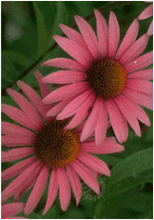
Echinacea purpurea, E. angustifolia, E. pallida
Echinacea is a member of the Aster family, the Compositae. We harvest the leaves, flower buds, roots and seeds for medicinal use: the above-ground parts (excluding the seeds) are harvested in July, the three-year-old roots in October, and the seeds at the beginning of February. Echinacea benefits greatly from frequent, shallow cultivation and application of a good side-dressing at the beginning, middle, and end of the growing season.
Elemental associations: Water
Phytochemistry: Essential oil, glycoside (echinoside), polysaccharide (echinacin), isobutylamides (echinacein), resin, betaine, inulin, a sesquiterpene (S. Mills)
Actions: Anti-viral, Anti-bacterial (against Staphylococcus and Streptococcus bacteria), Immune-modulating and Immunostimulant, Alterative, Lymphatic, Vulnerary
Specific systems: Lymphatic system
This is the remedy we should turn to when the lymph glands are swollen due to a viral infection of some kind, be it a cold, flu, or mononucleosis. It does very well in acute situations, giving the body a great boost to fight that infection off. However, it should not be used long-term as it tends to lose its effects. The only exception to long-term use that is of value is in the case of chronic tendonitis or other inflammation of the connective tissues, tendons, and cartilage.
Traditionally, its action on the lymphatic system has been used to clear the body of poisons and toxins, especially from snake, spider, and insect bites that are severely swollen. It functions quite well for ‘blood poisoning’, the condition that occurs when an infection has spread deep into the tissues and a red streak is issuing from the site (the dose, in these cases, is quite heroic!).
As an external remedy, the tincture makes a great disinfectant as it can kill Staph bacteria (they’re responsible for most infected cuts). It is also a great addition to a sore throat gargle, being again a specific against Strep bacteria.
Indications: Acute viral respiratory infections, snake and spider bites, ‘blood poisoning’, cuts and skin infections (even if severe), sore throat, tendonitis
Contraindications: Long-term use. Auto-immune conditions (theoretical)
Preparation/Dosage: A tincture is made from each plant part individually, harvested at the appropriate time, in 50% alcohol, 1:3. After maceration and straining, the tinctures are combined in these proportions: Roots 75%, Tops 20%, Seeds 5%.
Apply as needed for external use, but only for the first 24 hours after the wound.
Internally, the dose is 1 tsp. 3-5 times daily for acute viral infections, 1 TBS 5 times daily for ‘blood poisoning’, skin infections, and snake / spider bites.
